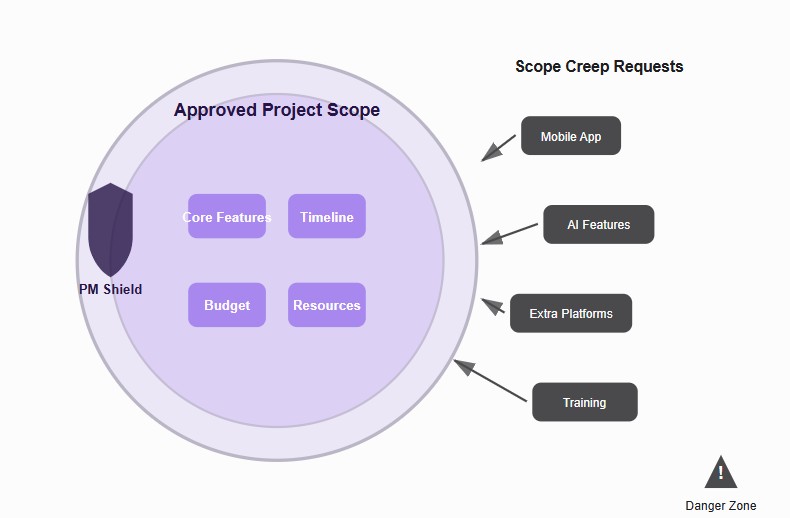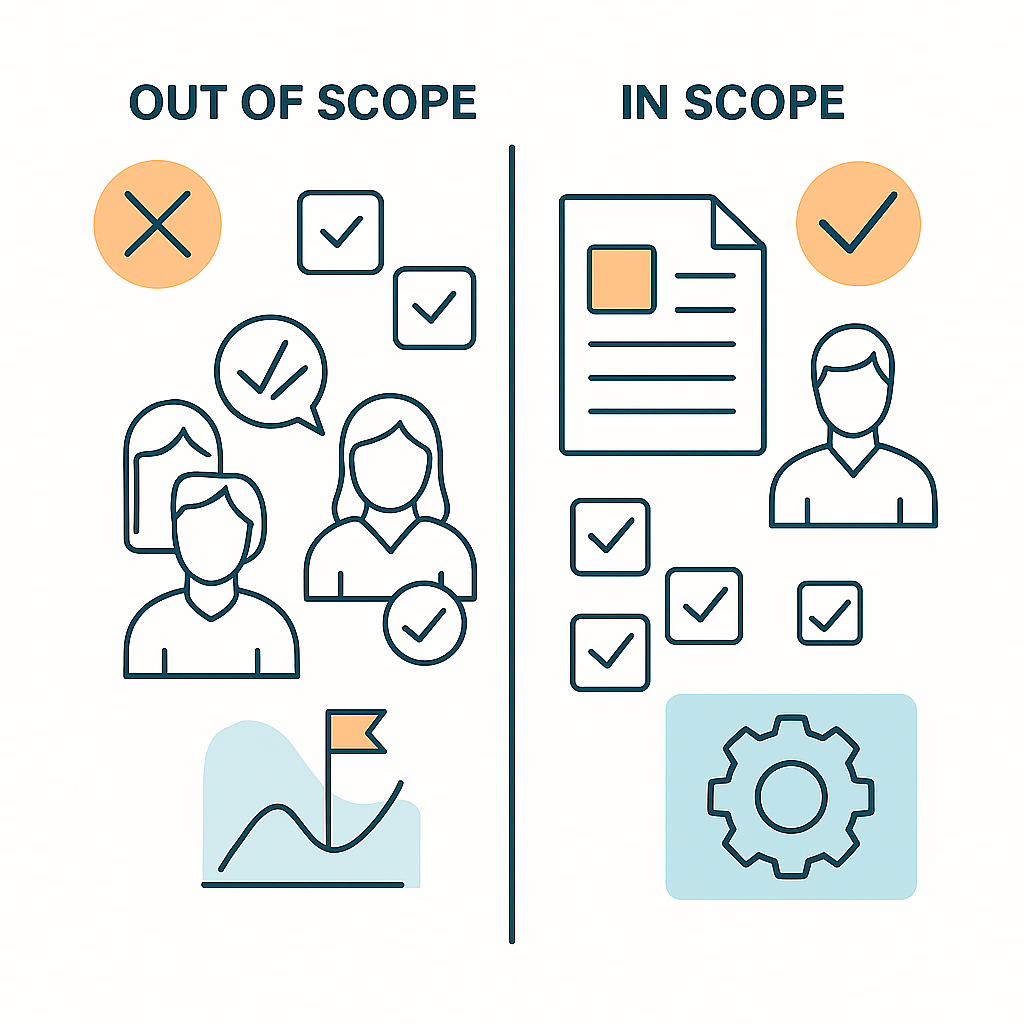Some of the costliest project failures didn’t crash from the start; they unraveled through small, unchecked requests. A single “quick add-on” can derail weeks of planning.
Understanding what is out of scope and why it matters for project managers is the key to protecting deliverables, preventing budget creep, and keeping your project from quietly spiraling out of control.
In this article, we will explore:
- Spot scope creep before it sabotages your project
- Set boundaries that your stakeholders can’t ignore
Out of scope: The silent project killer every PM must master
Imagine this: You're three months into a website development project with a crystal-clear timeline and budget. Suddenly, your client casually mentions, "Oh, and we'll need a mobile app version too - that's the same thing, right?" Your heart sinks.
Welcome to the world of out-of-scope work; the silent assassin that's responsible for derailing more projects than any other single factor.
What exactly is "out of scope"?
Out of scope refers to any task, requirement, or deliverable that falls outside the original agreed-upon boundaries of a project. Think of your project scope as a carefully drawn blueprint for a house. Everything inside those lines is what you've committed to build. Everything outside? That's out of scope territory.
Here's what this looks like in real-world scenarios:
In Software Development:
- Original scope: Build a basic e-commerce website with a product catalog and a shopping cart
- Out of scope request: "Can you add AI-powered product recommendations and multi-language support?"
In Marketing Projects:
- Original scope: Create social media strategy for Facebook and Instagram
- Out of scope request: "We also need you to manage our LinkedIn, TikTok, and create video content."
In Construction:
- Original scope: Build a three-bedroom house with standard electrical wiring
- Out of scope request: "Let's add a smart home system and solar panels while we're at it."
The common thread? These requests sound reasonable on the surface, but they represent significant additions that weren't planned, budgeted, or scheduled.

Why out of scope work is every project manager's nightmare
The numbers don't lie, and they're more alarming than most project managers realize:
- 52% of all projects face scope creep - that means more than half of your projects are under attack
- 41% of projects go completely out of scope, making it one of the top two reasons for project failure
- Organizations with poor scope management practices see scope creep in 52% of projects, while those with strong practices reduce this to just 33%
Translation: If you're not actively managing scope, you're essentially flipping a coin on project success.
Why this matters more than you think
Out of scope work creates a devastating ripple effect across your entire project. When boundaries blur, you're not just dealing with extra tasks; you're facing delays, increased costs, and frustrated stakeholders who expected you to deliver on time and within budget.
Your carefully planned project becomes an unpredictable chaos where original deadlines become meaningless and team productivity plummets.
You are the guardian: Your critical role as a project manager
As a project manager, you are the primary gatekeeper for maintaining project boundaries. This isn't just part of your job - it's one of your most critical responsibilities. Here's why this role is so crucial:
The buck stops with you
When projects fail due to scope creep, stakeholders don't blame the person who made the additional requests; they blame the project manager who allowed the project to spiral out of control. Fair or not, this is the reality of project management.
You're the scope detective
You must develop a sixth sense for spotting out-of-scope requests before they infiltrate your project. This means:
- Recognizing seemingly innocent requests that require significant additional work
- Understanding the true impact of "small" changes on your project's foundation
- Identifying stakeholders who consistently push boundaries
The art of professional "no"
Learning to say no professionally while maintaining positive relationships is perhaps your most valuable skill. You need to:
- Explain the impact of additional requests clearly and factually
- Offer alternatives that work within existing constraints
- Document everything to protect both parties
The hidden financial tsunami
The financial impact of out-of-scope work extends far beyond simple budget overruns. It creates a ripple effect that can devastate your entire organization:
Direct costs that multiply
- Unplanned labor hours at current or overtime rates
- Additional materials or resources not included in the original estimates
- Extended project timelines that delay other initiatives
- Rework and corrections when rushed out of scope work create quality issues
Opportunity costs that hurt
- Delayed product launches that miss market windows
- Resource allocation problems that impact other projects
- Client relationship damage that affects future business
- Team productivity losses that compound over time
Understanding out of scope work isn't enough - you need to actively protect your projects from this silent killer. The most successful project managers treat scope management as a proactive defense strategy, not a reactive damage control measure.
Build impenetrable project walls: The PM's defense blueprint
The difference between successful project managers and overwhelmed ones isn't talent or luck - it’s using strategies (and even project management software for startups) to create crystal-clear boundaries that stakeholders respect.
Think of scope documentation as your project's immune system: when it's strong, dangerous requests get filtered out before they can cause damage.

The foundation: Scope statement templates that protect you
Your scope statement and, by extension, your project management plan template PMBOK, isn't just paperwork; it’s your legal and professional shield.
Here's how to craft one that stands up to pressure:
Project objectives: The what
Write this in business language, not technical jargon.
Poor example: Implement a responsive web framework
Better example: Create a website that works perfectly on phones, tablets, and computers
Stakeholders need to understand exactly what success looks like.
Deliverables list: Exactly what they'll get
Be ruthlessly specific. Don't write vague descriptions - write detailed specifications.
Poor example: Website with a contact form
Better example: Contact form with name, email, phone, and message fields that sends notifications to admin@company.com
The more detailed you are, the harder it becomes for stakeholders to claim they expected something different.
Project boundaries: The not included section
This is where most project managers fail. They focus on what's included but forget to explicitly state what's NOT included.
Real-world template:
This project does NOT include:
- Integration with third-party services not mentioned in deliverables
- Training sessions beyond the single handover meeting
- Ongoing maintenance or updates after the 30-day warranty period
- Additional features or modifications to approved designs
Master class: Writing exclusions that eliminate arguments
The art of exclusions lies in anticipating what stakeholders might assume is included.
The common assumption method
Ask yourself: What would a reasonable person expect that we're actually not providing? Then explicitly exclude it.
Software Projects:
- Data migration from existing systems requires a separate scope and timeline
- User training beyond documentation is not included in this phase
- Mobile app versions are separate projects requiring additional planning
Marketing Projects:
- Content creation for platforms not specified in the deliverables list
- Paid advertising budget management beyond strategy development
- Ongoing campaign optimization after the initial launch period
The industry standard trap
Many stakeholders assume industry standards are automatically included. Make these explicit exclusions:
- SSL certificates and security features beyond basic password protection
- Backup and disaster recovery systems require additional planning and budget
- Compliance with specific regulations (GDPR, HIPAA, etc.) is not specified in the requirements
The stakeholder sign-off: Your insurance policy
Getting stakeholder agreement isn't enough - you need documented proof that they understood and approved the boundaries.
The three-layer approval system
Layer 1: Initial Review
Send the scope document with clear instructions:
- Please review the attached scope carefully, especially the Not Included section
- We'll discuss any questions during our approval meeting
Layer 2: Discussion Meeting
Walk through exclusions specifically. Ask the critical question:
- Are there any items in the exclusions list that you expected to be included?
Document their responses and any clarifications.
Layer 3: Final Written Confirmation
Never proceed without written approval. Use this template:
I confirm that I have reviewed and approved the project scope document dated [DATE]. I understand the deliverables, timeline, budget, and exclusions listed. Any requests beyond this scope will require separate evaluation and approval.

The read receipt strategy
Send scope documents requiring read receipts and responses. Include a deadline:
- Please confirm your approval by [DATE] so we can begin work as scheduled
This creates urgency and ensures engagement.
Your documentation defense system
Strong scope documentation works because it shifts conversations from emotional reactions to factual references.
When a stakeholder says they expected something different, you can respond professionally:
- Let's reference the scope document we both approved. This falls under the exclusions we discussed in section 3.2.
The psychology of clear language
Use positive framing for boundaries. Instead of saying we won't do something, position additional requests as future opportunities:
Poor approach: We won't do X
Better approach: Phase 2 opportunities include X, Y, and Z
This positions additional requests as future value rather than current rejections.
Your scope documentation should be so clear that a complete stranger could read it and understand exactly what the project includes and excludes.
Master scope limits to deliver with confidence every time
Scope creep doesn’t announce itself; it slips in through unclear boundaries and unchecked assumptions. As a project manager, your power lies in defining, documenting, and defending what’s not included just as clearly as what is.
Mastering scope limits isn’t about saying no - it’s about saying yes to the right things, at the right time, with confidence. When your scope is solid, your delivery is too.



_light%201.png)





